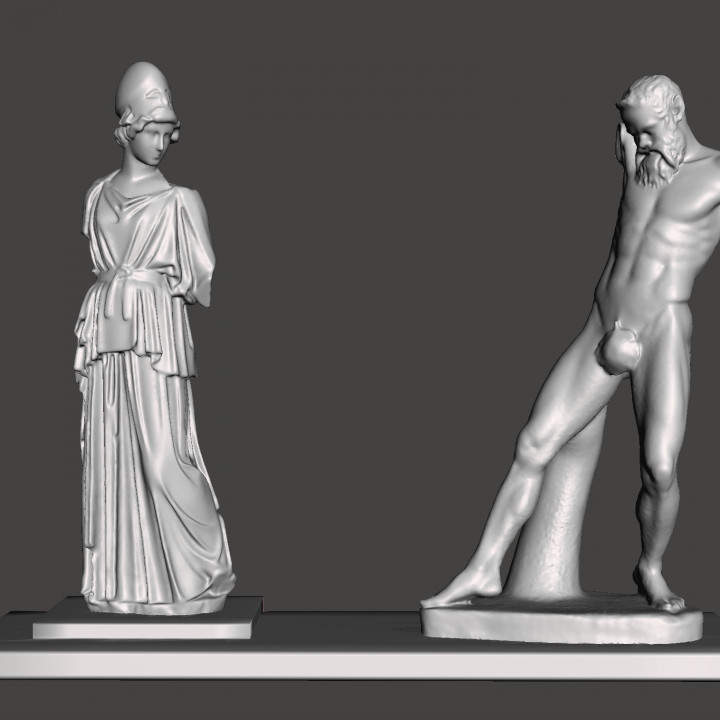
Athena and Marsyas group by Myron
myminifactory
History The Athena and Marsyas group was a bronze sculpture created by Myron of Eleutherai. The group was set up on the Acropolis in Athens. The original group has not survived. The group was copied in marble. The best preserved copy of the Athena is at the Liebieghaus Museum in Frankfurt, Germany. It was found in Rome in 1884 and acquired by the Liebieghaus Museum in 1909. The best preserved copy of the Marsyas is at the Gregorian Profane Museum in Vatican City. It was found on the Esquiline Hill in Rome in 1824. The group was a subject of ancient ceramics decoration and appeared on ancient coins, and ancient writings, aiding later scholars in identifying the group. It is from all these different sources that scholars recognized surviving marble copies of Athena and Marsyas. Subject The group represented the moment the goddess Athena threw down the auloi she'd created after discovering that playing the instrument caused her cheeks to puff out. The satyr Marsyas is seen discovering the discarded music instrument and reacting with surprise and delight as Athena looks on disapprovingly. That moment was part of the story of how Marsyas became an expert player of the auloi, eventually attracting the ire of the god Apollo, who considered himself the god of music. They had a music contest judged by the Muses who eventually declared Apollo the victor. Apollo had Marsyas flayed alive. Recreations Several modern reconstructions of the missing group in plaster or bronze were made using copies of the Frankfurt Athena and Vatican Marsyas. Missing elements were restored, although there is disagreement as to the exact position of some missing elements. A bronze recreation is at the Botanic Garden in Copenhagen, Denmark. A slightly different bronze recreation is in the gardens of the Liebieghaus Museum, Frankfurt, Germany. Plaster casts recreating the group were also made. A group, notable for being without any restorations to the Frankfurt Athena copy, can be seen at the plaster gallery at the Pushkin Museum in Moscow, Russia. The Vatican Marsyas copy does have restored arms. Another recreated version of the group can be seen at the National Museum in Szczecin, Poland. *This is a partial recreation of the lost bronze group of Athena and Marsyas by the sculptor Myron. The Frankfurt Athena and the Vatican Museum Marsyas were used in this 3D model. There are two models. One model is a single piece with all the elements merged together. The other model has the elements separate to be printed in different colors if desired (each statue, plus the long plinth under both figures, and the smaller plinth under the Athena). In both models, I had to set the Athena atop a short plinth to elevate the figure to be at an even level with the surface of the ground that the Marsyas stands on. The exact distance between the figures is my own guesswork based on photographs of recreations on display across Europe. The precise direction each figure was looking is also a matter of guesswork too.
With this file you will be able to print Athena and Marsyas group by Myron with your 3D printer. Click on the button and save the file on your computer to work, edit or customize your design. You can also find more 3D designs for printers on Athena and Marsyas group by Myron.
